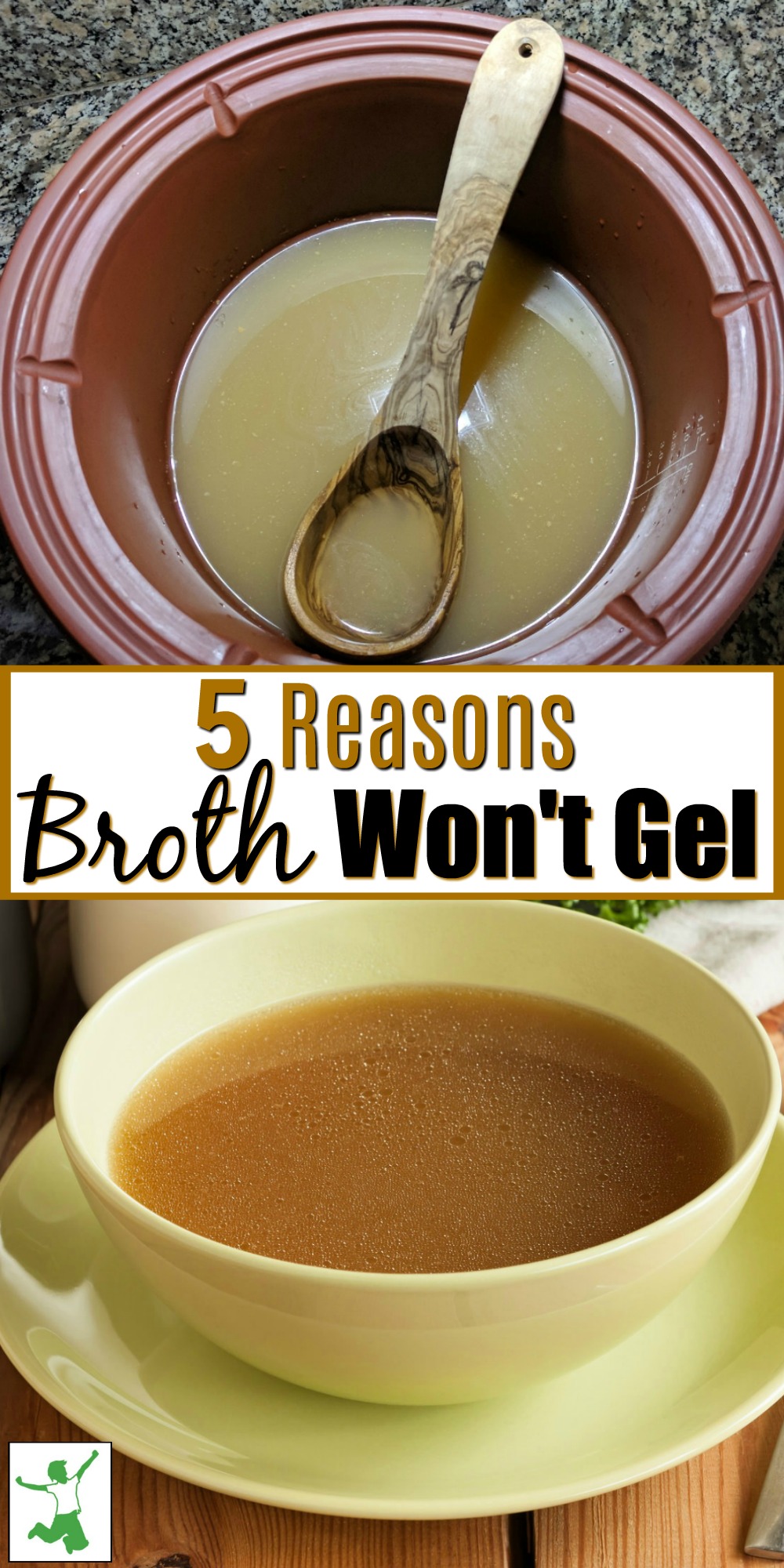
Do you have frequent trouble where your homemade broth doesn’t gel after being chilled in the refrigerator? This is a problem to solve quickly, as correct preparation is one of the foundational techniques of Traditional Cooking.
So critical is properly made, gelled homemade stock to the ongoing maintenance of health that Dr. Francis Pottenger MD, author of the nutrition classic Pottenger’s Cats, considered the stockpot the most important piece of equipment in the kitchen.
Homemade stock is so essential because it contains ample amounts of gelatin, a colloidal substance that attracts digestive juices to itself and prevents gastrointestinal bugs from attaching themselves to the gut wall and wreaking havoc. Natural gelatin both assists digestion and keeps you well!
In addition to gelatin, stock contains minerals such as calcium, silicon, sulphur, magnesium, phosphorus, and trace minerals all in a form that is incredibly easy for the body to absorb.
Do you take expensive supplements for joint pain or arthritis?
Simply adding homemade stock on a frequent basis to your diet will do your cartilage, tendons, and joints a world of good as stock also contains collagen, chondroitin sulfates, and glucosamine.
With homemade stock such a critical food to health, it is important to make it correctly. One sign that you have indeed performed the task well is that your stock gels beautifully once it is chilled in the refrigerator.
If you find that your stock won’t gel most of the time, here are the 5 typical reasons why as described by Monica Corrado, MA, CNC, and author of the blog Simply Being Well. Monica teaches cooking classes and does consultations, so be sure to check her website for this information if you could use some coaching.
Reasons Why Stock and Bone Broth Won’t Gel
- The stock rolled at too high a temperature. If stock or broth is simmered too high, the heat will break down and destroy the collagen. To see what the perfect simmer on your stock should look like, see my short video on the subject by clicking here.
- The stock did not roll long enough. Once you get that perfect simmer or “roll” going, be sure that chicken stock rolls for 6-24 hours and beef stock for 12-50 hours. Less than that will likely not draw enough gelatin into the stock from the bones.
- Not enough of the right kind of bones were used that yield gelatin. To get the right mix of bones that yield gelatin versus other types of bones that add flavor and color, make sure you use one of the following methods: 1 whole, free-range layer hen with neck and wings cut up, 3-4 lbs of boney chicken parts which includes a combo of necks, backs, and wings, OR the picked carcass of 2 meat chickens. For beef stock, use about 7 lbs bones total (4 lbs of boney bones and 3 lbs of meaty bones).
- Too much water was used in proportion to the bones. For chickens, the correct proportion is 3-4 lbs of bones per 4 quarts of filtered water. For beef stock, the correct proportion is 7 lbs of bones per 4 quarts of water or more to cover.
- Using bones from battery chickens or chickens raised in cages. Conventionally raised chickens or chickens raised in cages typically yield little to no gelatin. It is worth the extra money to get quality when you buy meat especially if you will be using those bones to make stock.
To get additional gelatin, add 2-4 chicken feet to the stockpot or even the head for even more! If your chicken is a rooster, add the comb. This will also add gelatin along with testosterone to the stock which adult men may find appealing as levels tend to decline with age.
Failsafe Solution If Your Stock Won’t Gel
If despite all your best efforts, you still come up with a pot of stock that does not gel, add 1 TBL of powdered gelatin per quart of liquid.
Vetted sources of good quality gelatin are available under the Supplements Section of my Shopping Guide.
Hopefully, these tips will help you solve the riddle of why your stock doesn’t gel so that the time you spend on this age-old culinary tradition is well spent producing the most nutrient-dense stock possible!

More Information about Gelatin
The Reason You Need More Gelatin in Your Diet
Gelatin and Collagen Hydrolysate: What’s the Difference?
The Benefits of Gelatin and How to Get More in Your Stock
Video: Stock that Gels!
More Information on Broth and Stock
How to Make Turkey Stock
The Healthiest and Best Bone Broth
How to Make Duck Stock
Rabbit Stock
How to Make Beef and Chicken Stock
How to Make Shrimp Stock
Confused about Stock versus Bone Broth?
The Perfect Simmer on Your Bone Broth








In the article Sarah you say that stock contains minerals such as calcium but you’ve previously posted articles this year saying research by WAP says stock has been found to actually contain very little to no calcium. I noticed this article is from 2012, prior to the research. I think you might need to update the article.
Sarah,
I read in another article that even if stock doesn’t gel from being heated too high, that it will still have all the “building blocks” of collagen, so your body is still getting the nutrition to make collagen. Is that accurate?
I have been making stock in crock pot and have never been able to get a boil this way; my guess is the heat is too high, even on low. But, I just assumed that the nutrition was still there, so it would be okay. Is this not correct? I was using nourishing traditions’ recipe, and she says crock pots can be used, so I was thinking it would be okay.
Thanks for your thoughts on that.
Still use your stock even if it doesn’t gel … it’s still a very beneficial food 🙂
Is my stock void of good nutrients if it doesn’t gel? Still have health benefits?
Thank you, Sarah! You come to the rescue again!
I have been so frustrated lately; when I made stock from chickens I bought at the grocer, everything worked almost effortlessly…the end result was lovely thick and gelatinous! But when I started budgeting for clean pastured chickens from a nearby farm, suddenly I could not get any gelatin from the carcasses…the end result was a pale, weak broth. I was even using feet, which I hadn’t done before.
I will pay closer attention to the amount of heat and water I use when trying to make stock, from now on. Perhaps that will make all the difference….
The video that you linked in number 1 of Reason Your stock won’t Gel section didn’t work.
I’m trying to understand the gelatin thing, but struggling a little bit. If stock doesn’t gel, does that mean that it has less nutrition in it? Or is it possible that it is just as nutritious but more diluted? i.e. you would have to consume more to get the same amount of nutrition, but it is all contained within the pot
When I bake a chicken, roast, after refrigerating, there is delicious jell. I eat it just as it is whenever I find it. Just wondering if this is a good idea, as I can’t always render the white fat from it.
Does this formation contain all of the good items as talked about in the above article?
Thank you for any information you may be able to give me.
This is great. I watched Alton Brown make stock a few years ago. He explained that when bones boil, they close up all of their pores, but when they simmer, those pores open up and release their good stuff. I simmer very gently, but according to this, was not simmering quite long enough. Thanks for the new tip! Merry Christmas!
Thank you for this…. I make stock ALL the time, and 90% of the time it gels…. I never knew about some of these facts! 🙂